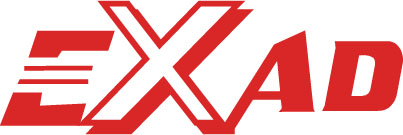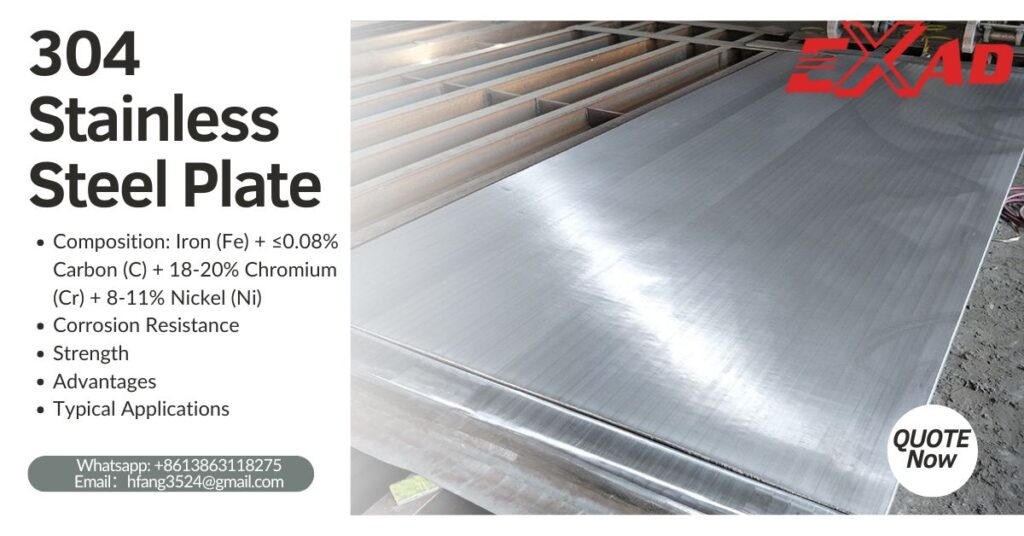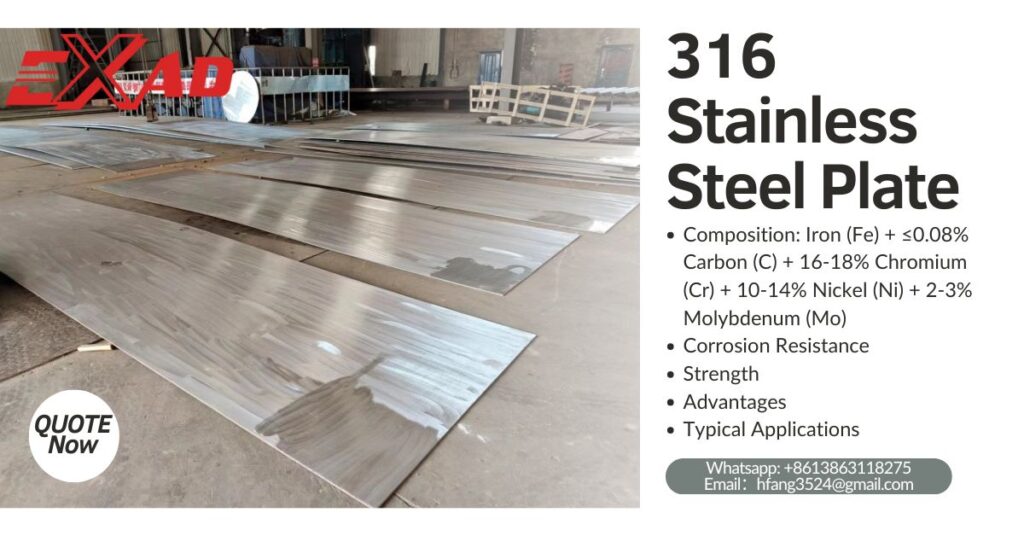Stainless steel is often a good choice when your project will be exposed to harsh environments. Corrosion resistance and high strength also become a factor when selecting a plate. Among the various types of stainless steel plates, 304 and 316 stainless steel plates are the most common. In this blog, Hong Fang will take you deep into the world of stainless steel. And reveal which grade of stainless steel has the highest corrosion resistance and why.
Understanding Stainless Steel plate
Stainless steel plate is very common in our daily life. But few people fully understand stainless steel plate.
You know, all steel is composed of iron and carbon and other alloys. Stainless steel is composed of iron as the base material, and then a large amount of carbon and a minimum amount of chromium are added.
Among them, the composition and content of 304 stainless steel are: Iron (Fe) + ≤0.08% Carbon (C) + (18.00-20.00) Chromium (Cr) + (8.00-11.00) Nickel (Ni)
The composition and content of 316 stainless steel are: Iron (Fe) + ≤0.08% Carbon (C) + (16.00-18.00) Chromium (Cr) + (10.00-14.00) Nickel (Ni) + 2-3% molybdenum
We can notice that chromium and nickel elements are one of the reasons why stainless steel is unique. 304 stainless steel was even called 18/8 stainless steel in the past. Because its chromium content is at least 18% and its nickel content is at least 8%.
Stainless Steel plate’s Grads and Families
You will find that when choosing Stainless Steel Composite Panel. Different stainless steels will have different labels. Most of them are families and grads. These two labels can tell us a lot of information.
There are four main types of stainless steel composite plate materials, namely: austenitic stainless steel plates, ferrous stainless steel plates, duplex stainless steel plates, martensitic and precipitation hardening stainless steels.
In addition, there are many grades of stainless steel plates. The three-digit identifier established by the Society of Automotive Engineers (SAE) has a long history.
More common are the six-character identifiers set by the American Society for Testing and Materials (ASTM).
However, these identification characters can all be called (UNS).
Among them, according to the SAE standard, 304 stainless steel can also be rated as:
EN number: 1.4305
EN name: X8CrNiN18-9
UNS: S30400
DIN: X5CrNi18-9, X5CrNi18-10, X5CrNi19-9
BS: 304S 15, 304S 16, 304S 18, 304S 25, En58E
JIS: SUS 304, SUS 304-CSP
We can see that the manufacture of stainless steel plates must meet the standards, and these standards have various grades. Hongfang Metal Company has professional production workshops and production equipment. Our professional team has been manufacturing stainless steel composite plates for 16 years. The manufactured stainless steel plates also meet the certification. If you want to know more, please feel free to contact us.
Comparing 304 and 316 Stainless Steel
The application of stainless steel composite plate details is very common. For example, kitchen utensils and gardening equipment at home. Or public telephone booths on the road, building walls, elevators, subways and other infrastructure. There are also various industrial industries such as food manufacturing, medical equipment, petrochemical plants, automotive and aviation parts. 304 and 316 stainless steel plates also have different application industries because of their different grades.
304 Stainless Steel Plate
304 stainless steel plate can be used in various corrosive environments, such as weak acid and alkaline solutions. But it does not perform well in high concentrations of chlorides. Because it is susceptible to pitting.
304 stainless steel plates can be used for part casting. It can be bent flexibly. It can also be welded, explosively bonded, etc.
304 stainless steel composite plates are very cost-effective. It is more suitable for pharmaceuticals, power generation, chemical processing, etc.
316 Stainless Steel Plate
316 stainless steel clad plate has 2-3% more molybdenum. So it has higher strength and hardness. It also performs well at high temperatures. So its corrosion resistance to chlorides will be better than 304 stainless steel composite panels. Therefore, 316 stainless steel composite panels are also more suitable for marine environments, chemical processes, petroleum industries, etc. Typical Uses: Food and Beverage, Cryogenic, Chemical Process, Medical (Hypodermic Needles, Implants, Stents), Instrument/Chromatography Tubing, Oil and Gas, Hydraulic Tubing, and Marine Applications. Super-austenitic grades (high nickel) offer extended performance for applications that require extreme corrosion and oxidation/scaling resistance or higher strength.
At the same time, 316 stainless Sandwich Panels will be slightly more expensive than 304.
Choosing the Right Stainless Steel
To determine the best stainless steel for your project, consider these factors:
Environment: High chloride or saltwater environments call for 316 or duplex stainless steel.
Cost: For general applications, 304 offers a cost-effective solution.
Temperature: High-temperature applications benefit from grades like 316 and specialized alloys.
Strength Requirements: Duplex grades provide superior strength alongside corrosion resistance.
In the world of stainless steel plate, the choice between 304 and 316 depends on the specific requirements of the application. If you are dealing with environments rich in salts, acids, or chlorides, 316 stainless steel panel is the most corrosion-resistant option. For less demanding environments, 304 remains a cost-effective and durable option.
Our team can help guide you in choosing the right alloy for your project. Choosing the right alloy can save you money and increase durability. Contact our team of experts today to start your metal project journey.



